► Five contemporary takes on old Skodas
► Skoda designers choose favourites to recreate
► Will they become a reality?
The ‘Skoda look’ is now firmly established, with models such as the Octavia, Scala and Superb all sharing the same angular design language. Skoda says its design ethos mirrors Bohemian crystal – because it blends function and style – and now the brand’s designers have it fused it with some famous models from the past. The project has been called Icons Get a Makeover; fortunately the designs show more creativity than the project's naming.
Skoda Voiturette A
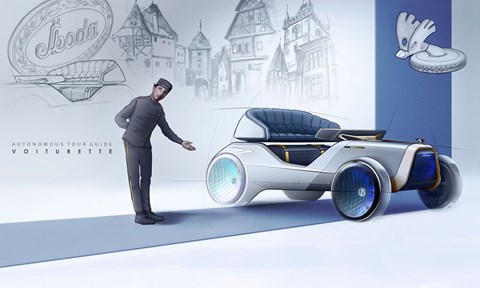
‘A model of this car once adorned my grandparents’ shelf in the kitchen. Now it sits on mine. I always loved the deep red paintwork. The Voiturette A was Skoda’s [then named Laurin & Klement] first-ever production car from 1905 and has been recently re-imagined as an autonomous tourist vehicle for the streets of Prague.’
Yuhan Zhang is a member of Skoda’s interior design team and saw a specific modern-day role for the Voiturette A. She explains: ‘I wanted to make a connection between the history of Skoda and beauty of Prague. There is a big display in the car presenting a description of the sights as you go, but it could also show passengers the history of Skoda.’
Like the original, Zhang’s recreation features a wide single seat and no roof.
Skoda 1203 Camper
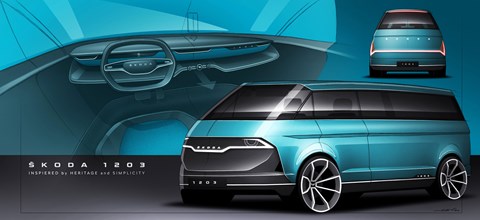
Skoda’s modern design is more evident in interface designer Daniel Hájek’s recreation of the 1203 van. While the Ford Transit was becoming an everyday sight in Britain, the Skoda 1203 was doing the same in Czechoslovakia and later the Czech Republic – it ran from 1968 until the '90s.
Such was its versatility, the 1203 was run by tradespeople, government departments and emergency services alike. There were minibus versions, ambulances, flatbeds, and even a 1203 hearse; there was a 1203 model for every eventuality.
Hájek’s new 1203, sitting on the Volkswagen Transporter platform, is a pop-top camper. He thinks it is a great embodiment of Skoda’s current values – a ‘modern vehicle that pays homage to the legend’ – rather than a retro retread. That’s why there’s only a faint reference to the original's circular headlights. In keeping with theme of modernising, Hájek also sees the new 1203 as an electric car, which would allow for even more space inside.
Skoda Felicia Cabriolet
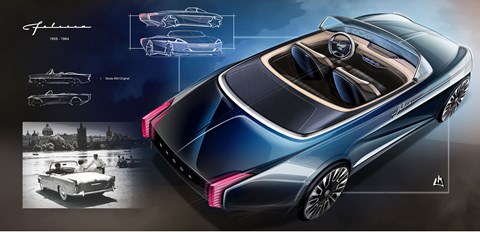
The challenge for Skoda’s interior designer Martin Leprince with reimagining the 1959 Felcia was keeping the original’s grace and elegance.
Leprince spent many hours with the original Felicia Cabriolet, and one of the features he favoured most was the wraparound windscreen. It became one of the defining styling cues of his modern take.
Leprince's principal reason for selecting the Felicia Cabriolet was simply because he wanted to recreate a convertible. With a cabriolet ‘you can see the exterior and interior at the same time,’ he says. With the ‘floating’ windscreen and curved instrument panel, there is a seamless connection between interior and exterior.
Skoda Popular Monte Carlo
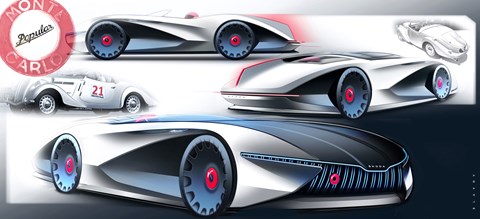
The Skoda Popular Monte Carlo is one of the prettiest cars of the pre-war period. And if the new design ever came to fruition, it would surely be among the best of this era as well. Like the others, interior designer Ljudmil Slavov talks of practical elegance too. ‘Functionality, practicality, elegance and purity remain our fundamental principles today,’ he says. So he kept the Popular’s centre instrument panel but – in true 21st century fashion – made the new one a kind of hologram.
Naturally, there is an exaggerated element of sportiness to the Popular too. That is certainly highlighted by new glass covers protecting storage space for racing helmets behind the seats. Like the original, the new version is super streamlined.
Skoda 130RS
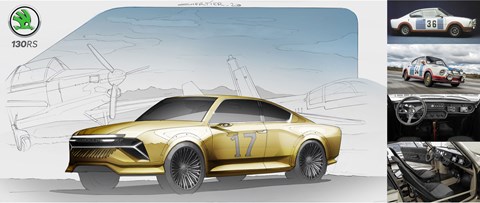
In contrast to Hájek’s 1203 recreation, Aymeric Chertier did want to simply refresh the old look. Skoda’s 130RS was one of the company’s greatest motorsport hits, certainly its greatest during the 1970s. Retaining the 130RS’s intent and performance was Chertier’s goal.
The resulting retro take on the ‘Porsche of the East’ has kept its long, Alpine A110-like tail and square jawline up front.
But on the inside, there is more modern engineering. The rollbar is a load-bearing part of the car’s chassis, and the dashboard is thoroughly new. It uses a full-length screen with three information zones: speed and revs in front of the driver; nav in the middle; and the passenger gets a choice of other views.
The original saw significant success on both tarmac and loose-surface circuits. The 130RS’s biggest victory was winning the 1977 Monte Carlo Rally.
Will we see any of these in production?
Sadly not, though it’s possible that these projects could become inspiration for future models. Renault, Honda and others are modernising old ideas and placing them on emission-free powertrains, so it’s possible Skoda could do the same.